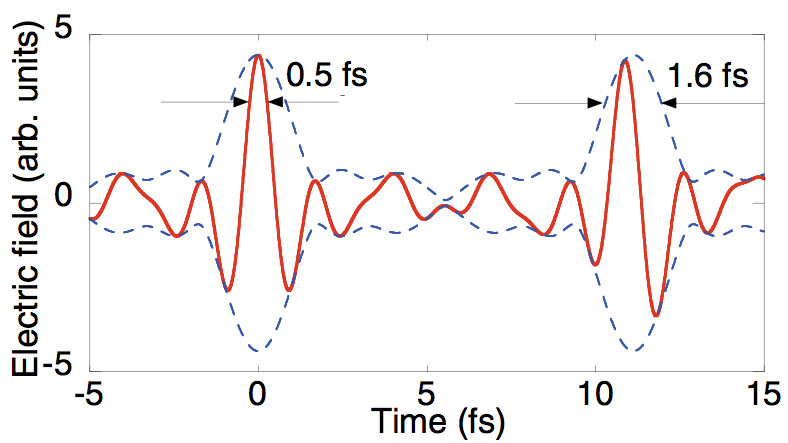![[a) vibrational
spectrum, b) rotational spectrum, c) multiplicative spectrum]](spectra.jpg)
In "Light Modulation at Molecular Frequencies", we have verified the spatial and temporal coherence of the sidebands by isolating three of them and modifying their phases to generate either amplitude or frequency modulated light. The nature of the light's modulation is determined by sending the combined beam again through a cell of deuterium vapor. Since the molecules only vibrate coherently when driven by the relatively slow oscillations of the field envelope, amplitude modulated light causes the molecules to generate new sidebands while frequency modulated light is transmitted without change. Essentially this technique provides a way to measure the phase of the molecular coherence.
"Optical Frequency Conversion by a Rotating Molecular Waveplate" shows that driving a rotational-vibrational transition with two opposite circularly polarized beams creates a coherent molecular motion, but one that cannot generate a spectral comb, due to conservation of angular momentum. Instead it can convert a third optical beam into a fourth with a peak photon conversion efficiency of 13%.
From the beginnings of this work, the possibility of making collinear, coherent sidebands invited the question of whether the long-standing record for the shortest optical pulse (4.5 femtoseconds or around 2 optical cycles) could be broken. In "Femtosecond Light Source for Phase-Controlled Multiphoton Ionization", we describe the use of xenon ionization to show some degree of temporal compression in sets of as many as five sidebands, from which we infer the generation of trains of pulses of width 2 femtoseconds.
We have also demonstrated that this technique has broad applicability: in "Rotational Raman generation with near-unity conversion efficiency", we extend our technique to the rotational transition of hydrogen, which due to larger coupling constants, allows us to generate 37 collinear sidebands in the visible and IR, with near-unity conversion efficiency from pumps to other spectral components.
For femtosecond-time-scale pulse shaping, a spectrum needs two crucial elements: large bandwidth and high spectral density. An easy way to generate a large number of spectral components from our Raman source is to cascade two Raman generators in series. The cascaded system is driven by three lasers. The first pair drives the Raman transition of the first cell, the second pair drives the Raman transition of the second cell. Such a cascaded system results in a multiplicative increase in the total number of generated sidebands. If the first cell alone generates Na=10 sidebands, and the second cell alone generates Nb=10 sidebands, the cascaded system generates Na*Nb=100 sidebands. When phase-locked, the peak power enhancement and average periodicity also scale as Na*Nb, so this multiplicative technique can produce pulses that are separated by picoseconds in time. The theory is described in detail in "Raman technique for single-cycle pulses".
Experimental demonstration of the multiplicative technique for increasing
spectral density:
![[a) vibrational
spectrum, b) rotational spectrum, c) multiplicative spectrum]](spectra.jpg)
In Raman self-focusing at maximum coherence, we use opposite circular polarized light to prepare a strong, coherent rotational oscillation in molecular hydrogen. As this oscillation is driven by beams with Gaussian spatial profiles, the spatial dependence of the refractive index change forms a Raman lens which causes the driving beams to self-focus or self-defocus depending on the sign of the detuning. We believe this to be the first demonstration of true Raman self-focusing.
Building on this demonstration, we calculated that with two opposite-circularly-polarized frequencies separated by a resonance frequency, it is possible to drive a medium in a way such that self-focusing can balance diffraction. Such "spatial Raman solitons" can be extended to allow a full comb of sidebands to propagate through a medium without diffracting. More recently, we have extended these simulations to show stable solitons in 2 transverse dimensions. This is one step closer to the Holy Grail of the soliton field, the real live spatial-temporal soliton, aka "the light bullet".
Our experimental demonstration of the multiplicative spectrum and its phase coherence are documented in Quasiperiodic Raman Technique for Ultrashort Pulse Generation.
Finally, we devised a scheme for synthesizing waveforms out of 7 vibrational sidebands between 400nm and 1.6 microns. We characterized these waveforms via four-wave-mixing and found that we could make pulse envelopes with a width of 1.6 femtoseconds which corresponds to less than 0.8 optical cycles.  Generation of a Single-Cycle Optical Pulse describes all the cool details. We spun this FWM measurement technique off into an approach to untangling the amplitudes and phases of the original spectrum (for small numbers of sidebands, with some caveats) in Measurement of Fourier-synthesized Optical Waveforms.
Generation of a Single-Cycle Optical Pulse describes all the cool details. We spun this FWM measurement technique off into an approach to untangling the amplitudes and phases of the original spectrum (for small numbers of sidebands, with some caveats) in Measurement of Fourier-synthesized Optical Waveforms.
We wrote a review article covering most of this work. We also wrote some more accessible articles describing our work: one on the multiplicative technique for Optics and Photonic News, A Quasiperiodic Approach to Ultrashort Pulses, which features some nice pictures of our multiplicative spectrum, and the other for Photonics Spectra about the single-cycle optical pulses, Breaking the Single-Cycle Barrier, which features ads.
Coming soon... stupid frequency comb tricks!
Things to doToytown Munich - All-purpose introduction and reference to living in Munich and Germany, for the English-speaking expatriate. Toytown Ultimate Frisbee - Sundays and Wednesdays in the English Garden Some directions that I wrote up for guiding newcomers (or the easily lost) to the field where we play Ultimate Frisbee on Sundays. My advice to newcomers to Germany In November, the Sueddeutsche Zeitung usually newspaper runs a "Schnitzeljagd", a kind of treasure hunt where the object is to track down a sequence of photographed locations in Munich. |
The MPQ version of this page is here.